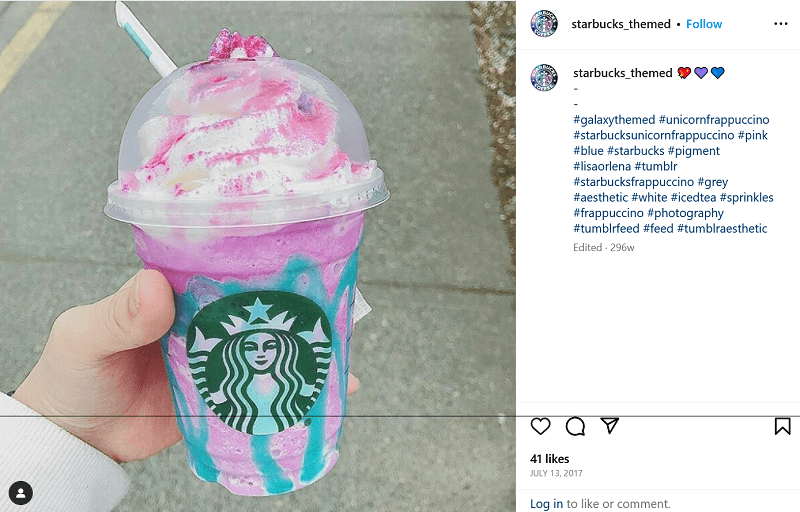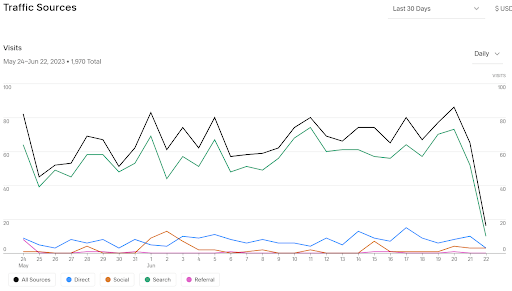The seasons are changing, and that means it’s time for a new marketing campaign for your business. The key to any successful marketing campaign is to reach your ideal customers where they spend their time. And in 2023, that place is social media.
According to research, over 70% of the entire U.S. population actively uses at least one social media platform, making it a great place to promote your business. But like any sort of campaign, being successful on social media requires extensive planning. Here are nine steps to help you design an effective seasonal marketing campaign for your business on various social platforms and develop fast, professional content using social media templates.
Step 1: Start early
It takes some time to plan, create content, and execute a social media marketing strategy. So if you’re planning a summer campaign, don’t get started on June 1st.
If you really want to get ahead of the competition and hit the ground running with your seasonal campaign, get started at least two or three months before you want the campaign to start. That should give you enough time to really flush out your ideas and ensure the execution goes smoothly. Last-minute marketing scrambles are no fun, and they lead to potentially costly mistakes — whether in the form of money or brand image.
Step 2: Set your goals
You have to know where you’re going if you want to get there effectively. Step two for building an effective seasonal social media marketing campaign is to set your goals.
Goals provide two valuable pieces for your marketing strategy. First, goals give you somewhere to go. It’s easier to see the route to success when there’s a final destination. Second, they keep everyone on your team organized. There shouldn’t be as many distractions when everyone knows the end goal.
What is it you want to achieve with your seasonal marketing campaign? Do you want to get more customers to visit your business, sell a specific product or service, or simply collect more contact information for your email campaigns?
Whatever your goals are, sit down and define them clearly before you start building your strategy. It’ll make every other step go much more smoothly and encourage a successful campaign.
Step 3: Identify your target audience
Next up, you want to identify your target audience. Who do you want to reach? This will help you determine the best social platforms to use, your tone of voice, and type of content you want to create in your marketing campaigns.
The best way to identify your target audience is to think about your customers. What demographic(s) are most common amongst your regular buyers. Think about things like:
- Age
- Gender
- Income
- Location
- Education
- Family size
You’re also welcome to add any other demographic information that would be relevant to your business. For example, if you sell sporting goods, the types of sports your customers are interested in would be an important part of an audience analysis.
Build a profile of the kinds of people you want to reach and keep this information in mind as you continue building your seasonal social media marketing campaign.
Step 4: Pick your social media platforms
There are several social media platforms you can use to promote your business, but they’re not all created equal. You could create a unique social media marketing strategy for every platform, but that might not be the best use of your energy. Instead, think about your audience and choose the platform(s) they use the most.
For example, if you want to reach an older audience, Facebook will likely be the most effective platform for you, with 41% of the platform’s users being over the age of 45. Instagram, on the other hand, has more than 50% of its user base under the age of 35.
Once you have a list of platforms your target audience uses the most, create your account (if you don’t have one already), and start thinking about strategy.
Step 5: Get creative with your strategy
Now it’s time for brainstorming. What are some marketing ideas that will set you apart from the competition and really make your seasonal campaign soar? For this step, you’ll need to consider your ideal audience, social platform best practices, and your branding.
Different audiences react differently to marketing messaging. For example, posting a bunch of current memes probably wouldn’t make an impact on an older audience. They’d likely just pass over your content without giving it a second thought.
Similarly, social platforms all work differently. Facebook and Instagram are great for static social media templates and photos, while short videos work best for TikTok and YouTube. Beyond content format, it’s also important to understand the culture for each platform. Making funny jokes or remarks is perfectly acceptable on informal platforms, but don’t try the same strategies on a professional platform like LinkedIn.
Finally, you’ll need to keep your branding in mind. Seasonal marketing campaigns might be temporary, but it’s no time to completely change your brand tone. Your business has developed an image through its previous content, messaging, and the way it interacts with customers. If you’ve built an image on knowledge and professionalism, this is no time to start making silly jokes on social media.
The best place to start when it comes to identifying a strategy is to look to other users. Businesses are running new social media marketing campaigns all the time. See which ones have worked and use the ideas to influence your next campaign.
For example, remember when Starbucks came out with the Unicorn Frappuccino? It was a seasonal social media campaign that swapped the drab, brown coffee that, quite honestly, isn’t entirely photogenic for a colorful blast of sugary goodness for a short season.

This campaign was incredibly successful because it was colorful and magical, which appealed to Starbucks’ younger audience. It became so popular that people dressed as Unicorn Fraps for Halloween!
For an extra dose of creativity, ask your coworkers if they have any ideas. You might be surprised with the brain power you already have in-house!
Step 6: Determine the perfect call to action
The call to action (or CTA) is the final push for your audience. It tells them the next step to take in the buyer’s journey, which should ideally lead toward the goals you set in the second step.
Calls to action can be tricky. It’s a fine line between gently guiding and forcibly pushing customers to the next step. Make your CTA messaging something that would appeal to your ideal audience without sounding overbearing.
For example, think about how you would feel when looking at two different CTA buttons on a social media post that say, “Buy Now” or “Learn More.” “Buy now” feels pushier. Perhaps the customers aren’t ready to buy yet, and they’re waiting to get more information. In this instance, the “buy now” CTA would actually discourage them from taking the next step, costing you a sale.
With “learn more,” you’re guiding users to the next step, which is seeking more information. It’s less salesy, which is better for certain audiences. Take them to a page on your website where they can learn more about the item or service you’re promoting.
Ideally, you should include some sort of CTA on each marketing post. Without a CTA, viewers won’t know the next step to take, which means they’ll most likely keep on scrolling through their social media feeds. It could even be something as simple as “visit our website” or “sign up for our newsletter.” Whichever CTAs you choose, make sure they align with the goals you set earlier.
Step 7: Set a posting schedule (and follow it)
Just like with any marketing campaign, consistency is key. According to the Rule of 7 (which seems fitting for Step 7), customers need to see your messaging at least seven times before they make a decision about purchasing. On social media, that poses a problem.
There are millions of posts uploaded to social media every day. If you post only twice per week, what are the odds potential customers will see your messaging in the cacophony of content they view on a daily basis? The only way to combat this issue is to set a regular posting schedule.
Ideally, you want to post your seasonal marketing content to social media between five and seven times per week — depending on the channel. The more you post, the more likely customers will be to hit that magic number of views to make a purchasing decision.
Get a calendar and mark the days you want to post for each platform you plan to use throughout the promotional season. This will help you stay on top of posting and maintain consistency with your marketing campaign. Of course, this is often where many marketer’s eyes get too big for their stomachs. It takes time and energy to create content, so make sure you don’t overextend yourself or your team members.
Step 8: Create content with social media templates
With all the other pieces in place, it’s finally time to start producing content. Content is the final step before launch because it’s the most important. You want to make sure you fully understand your goals, audience, strategy, platforms, CTA first, so you can use all that information to inform your content development. That’s why it’s so important to follow step one and start early!
All content you post to social media needs to be of the highest quality. You’re competing with professional content creators for attention! And unfortunately, creating all that high-quality content to fill your schedule takes time. Luckily, there are some ways to speed up the process, like social media templates.
Professional services templates for social media are a great way to get professional content without needing professional graphic design skills — or the time to learn them. Simply browse through the templates, choose the ones that best fit your brand’s style, fill in the information, and you’re ready to post.
You can easily create dozens of social posts of your seasonal campaign in just a few hours, rather than starting everything from scratch. Many of the templates allow you to add exciting text options, so you can give viewers more information about your seasonal promotions right in the graphic.
There are templates for just about every social media platform and business out there, so feel free to explore!
Step 9: Monitor the results
Just because you finally scheduled all your campaign posts doesn’t mean you’re done! There’s still one more step, and it’s arguably the most important. You need to monitor the ongoing results of your seasonal social media marketing campaign.
Without monitoring your campaign results, you’ll never know if it was effective! Keep tabs on some of the most important key performance indicators (KPI), including:
- User Engagement
- Impressions
- Reach
- Likes
- Follower growth
- Traffic conversions
- Interactions (comments and direct messages)
- Shares
- Website visitors by channel source

Not only can monitoring results help you determine the success of your campaign, it can also influence future campaigns.
For example, if you notice social media templates with animations cause user engagement to go way up, you’ll know to use more animations in your future campaigns. Over time, you can use your metrics to build the most efficient social media marketing campaigns possible!
Grow your business with effective seasonal social media marketing
Tis the season for promotions! But before you hit social media to promote your business, it’s important to take the time to create a proper social media marketing campaign. Remember to create concrete goals for your seasonal campaign, identify your target audience, choose the right platforms, come up with a creative strategy, write a compelling CTA, set a posting schedule, use plenty of social media templates to create professional content, and track your metrics. And don’t forget to start early so you have plenty of time to develop your strategy!
By following these nine steps, you can create a social media marketing campaign that’ll draw in all sorts of new business this season.




